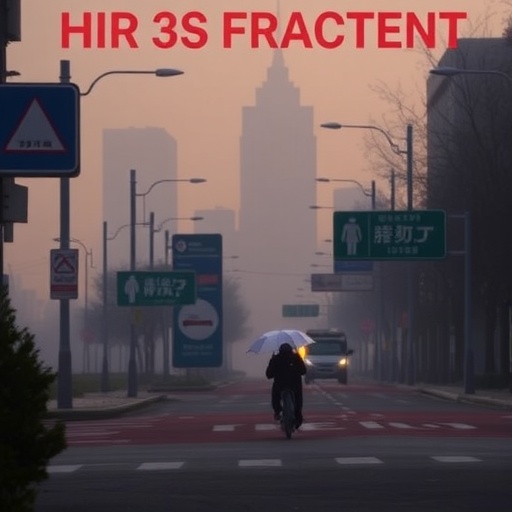The intersection of air quality and health has garnered increasing attention in recent years, particularly regarding its effect on vulnerable populations such as older adults. A groundbreaking study led by Liu et al. has underscored the complex relationship between air pollution exposure and the risk of hip fractures among older individuals. This multi-center time-series study, published in BMC Geriatrics, provides crucial insights into how environmental pollutants can exacerbate health risks in the aging population.
The research used dynamic multivariate distributed lag nonlinear models (DLNM) to analyze extensive data across multiple centers. By employing sophisticated statistical methodologies, the authors aimed to capture the nuances of how varying levels of air pollution affect health outcomes over time. The methodology encompassed a comprehensive temporal assessment, revealing patterns that may otherwise be overlooked in simpler analytical frameworks. The nuanced analysis demonstrates that merely correlating pollution levels with fracture rates does not suffice; rather, understanding the lagged effects of pollution exposure is paramount.
One significant finding from the study is the identification of specific air pollutants that are particularly harmful. Prevailing research has often focused on particulate matter (PM), but Liu and colleagues broaden their scope to include a range of pollutants such as nitrogen dioxide (NO2) and sulfur dioxide (SO2). These pollutants are common in urban environments where traffic and industrial activities are concentrated, making this research especially relevant for city dwellers. The results indicate that exposure to these pollutants is correlated with increased risks of hip fractures, emphasizing the critical need for policy interventions targeting air quality improvement.
The vulnerability of older adults to physical injuries, particularly fractures, is underscored by various factors such as reduced bone density and balance issues. This study highlights how environmental factors can compound these inherent vulnerabilities, presenting a stark reminder of the challenges posed by urban living. The discussion of intersectionality in health, incorporating environmental, social, and biological factors, opens up new avenues for research and public health interventions designed to mitigate these risks.
Moreover, the research has implications for healthcare policy and urban planning. As cities continue to grow and more individuals migrate to urban areas, understanding the health ramifications of poor air quality is crucial. The findings prompt policymakers to reassess their strategies regarding urban infrastructure and public health initiatives. By prioritizing improvements in air quality, cities can mitigate health risks, particularly for the aging population that is increasingly susceptible to bone-related injuries.
Notably, the study also discusses how environmental factors should be integrated into injury prevention strategies. Health education programs could include awareness of air pollution impacts alongside traditional fall prevention tactics. This holistic approach could potentially lead to better health outcomes and foster a sense of community responsibility toward environmental stewardship.
Additionally, Liu et al. highlight the importance of continuous monitoring of air quality and health outcomes. This ongoing research could inform future healthcare policies and guide community efforts in reducing pollution levels. By examining the long-term trends of air pollution and its corresponding health impacts, studies like this one pave the way for more targeted public health initiatives designed to protect vulnerable populations.
This research is a part of a growing body of literature that connects environmental health risks with aging and chronic illnesses. It signals a paradigm shift in how we understand the role of air quality in overall health and well-being. While the focus has traditionally rested on individual behaviors and lifestyles, this study emphasizes that environmental factors are equally critical in shaping health outcomes.
The study’s conclusion paints a compelling picture of the future of public health as it relates to environmental policies. There is an urgent need for collaborative efforts between healthcare providers and environmental scientists to address these findings comprehensively. Stakeholders must work together to communicate the risks associated with air pollution and advocate for policies that prioritize clean air.
As the world adapts to the challenges posed by climate change, further research in this domain will be instrumental in formulating effective interventions. Liu et al.’s insights advocate for a proactive approach in environmental health management, suggesting that addressing air quality could yield significant health benefits, especially for older adults.
In summary, the implications of Liu et al.’s study extend far beyond academic circles. The findings are poised to resonate in the realms of public policy and personal health, raising vital questions about how cities can evolve in ways that honor the health of all inhabitants—especially the most vulnerable. The intersection of environmental health and aging presents a compelling narrative that warrants attention and action, prompting a collective effort to safeguard our health against the backdrop of urban pollution.
Through explorations such as this, we can make strides not only in understanding the intricate connections between air pollution and health outcomes but also in forging pathways toward healthier urban living. As we move forward, the ongoing conversation about air quality and its implications on public health will be critical in shaping a healthier future for all communities.
Subject of Research: Air pollution and its effects on hip fracture risk in older adults.
Article Title: Air pollution and hip fracture risk in older people: a multi-center time-series DLNM study.
Article References:
Liu, S., Chen, W., Han, Y. et al. Air pollution and hip fracture risk in older people: a multi-center time-series DLNM study.
BMC Geriatr 25, 848 (2025). https://doi.org/10.1186/s12877-025-06409-3
Image Credits: AI Generated
DOI: https://doi.org/10.1186/s12877-025-06409-3
Keywords: Air pollution, hip fracture risk, older adults, public health, environmental factors, dynamic multivariate distributed lag nonlinear models, injury prevention strategies.
Tags: aging population health researchair pollution and hip fracturesair quality impact on bone healthcomplex relationship between pollution and healthdynamic multivariate distributed lag modelsenvironmental pollutants affecting elderlylongitudinal assessment of air pollutionmulti-center health studiesnitrogen dioxide exposure effectsparticulate matter and fracturessenior health risks from pollutionstatistical methodologies in health studies




